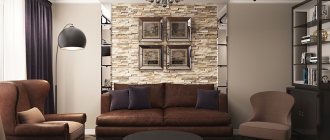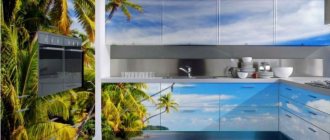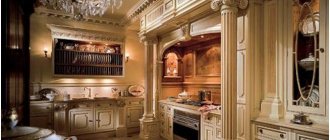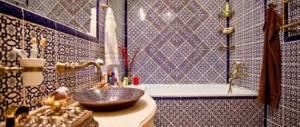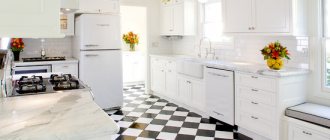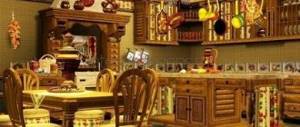When improving a home after leveling the floor, everyone wants to have an ideal plane with a beautiful shine or pattern. Every year, new methods of decorating residential premises are developed and implemented, including self-leveling flooring, which at first could only be done by professionals.
Hardening self-leveling surfaces are gradually replacing some traditional materials. Aesthetics, convenience, reliability and lack of seams are the main characteristics inherent in bulk polymer.
This technology is easy to master if you listen to the advice of experts.
What is important to know about self-leveling floors
Not everyone has seen an aesthetic self-leveling floor with a 3D pattern, but many have looked at such a surface in supermarkets and salons. If you want to have such beauty, you most often turn to specialized companies.
But a simple self-leveling polyurethane self-leveling floor is also available to those who like to do their own repairs.
Floors need to be properly prepared for a seamless finish. It can be poured onto any hard, flat surface:
- ceramic tiles;
- cement screed;
- fractional fillers (colored pebbles);
- concrete slabs after leveling;
- “warm floor” system in concrete;
- wooden floors or slats.
Ideally smooth floors are completely environmentally friendly and safe for health, since they do not emit harmful fumes. After uniform distribution and hardening of the polymer, a wear-resistant and durable base is obtained that is not afraid of mechanical damage.
Black varnish polyurethane looks expensive and luxurious, even if applied to ordinary concrete, as in the photo of the self-leveling floor.
You want to sit, lie or dance on such a floor – it seems warm and comfortable. This is an excellent solution for many interior styles.
Today there are many shades available to ensure a seamless surface to enhance any design concept. The most popular are plain dark floors with a glossy effect. But specialized firms are mastering new technologies to offer clients complex color and mosaic variations.
Experts advise monitoring the thickness of the self-leveling layer. Thin coating - up to 1.5 mm, it can crack or deform under heavy load. A thick layer takes a long time to dry and is expensive, and the feeling of lightness is often lost. This finishing option is not suitable for old and sagging houses.
Polymers are somewhat similar to the properties of “living matter”; when working with them, certain temperature and humidity parameters are required.
When hardening, it should be at room temperature, without drafts, moderate air humidity - up to 80%. Then the distribution and “setting” will be uniform, and the texture of the coating will acquire the best aesthetic parameters.
Advantages and disadvantages of self-leveling coating
The self-leveling floor in the kitchen looks quite stylish and unusual. Modern technologies make it possible to obtain a variety of images, from 3D self-leveling floors in the kitchen to imitation of natural wood and stone.
It is worth noting that all the images look quite realistic, which allows us to erase the boundaries of human consciousness.
The floor covering has no connecting seams. Due to the presence of chemical components, this coating can last for many years.
Today, a shiny surface can be replaced with a matte, plain coating. Everything depends on the wishes of the customer.
The advantages of gender include:
- stylish interior design;
- no flaws;
- easy cleaning of the floor surface using household chemicals;
- excellent resistance to mechanical stress;
- original design solution.
As for the shortcomings, there are practically none. Recently, kitchens with self-leveling floors have become very popular among consumers.
About security measures
The work is carried out in protective glasses, gloves, closed clothing and special shoes, “paint shoes”.
The alkaline reaction when stirring the polymer solution can cause a burn. To avoid inhaling the “chemical” smell of the liquid mixture, before making a self-leveling floor, stock up on a respirator.
After completing the process, be sure to ventilate the room, but without sudden temperature changes and large drafts.
Negative aspects of polymer self-leveling floors
It is impossible not to mention when considering the advantages of a self-leveling floor and the disadvantages of such a surface. The arrangement of this coating requires high-quality preparation of the base. When installing indoors, it is necessary to ensure positive temperatures and the absence of drafts. The duration of the process can reach 2-6 weeks, which is determined by the area being treated and the quality of the composition.
Note! To get a good final result, it is better to entrust the filling of the floor with a polymer composition to a specialist.
The duration of the installation process of a self-leveling polyurethane floor can reach 2-6 weeks.
The arrangement of such a floor requires a significant amount of material, which will entail serious financial costs, which are multiplied when creating a reliable foundation. Installation of coating is a complex and expensive process, for which it is recommended to use the services of specialists to perform it efficiently.
The polyurethane surface is quite cold to the touch, which can cause some discomfort during operation. The coating is characterized by toxicity due to the fact that the material contains a large number of harmful components, among which are phenol and formaldehyde. This type of floor is practically impossible to restore. It is possible to eliminate only some minor defects.
What decor to choose for self-leveling floor?
Any finishing surface has properties that together give a special effect. Self-leveling floors are an ordinary liquid medium that spreads, hardens and, after drying, meets the stated characteristics.
Decoration is done in different ways, for example, by adding “color” (pigment), quartz sand and other inclusions. Floors with “chips” or colored inclusions are obtained by adding acrylic paint.
Polymers and bases of different colors create patterned floors or original designs.
Preparatory step
I want to see everything!
I want to see everything!
The self-leveling coating can be poured onto wooden, concrete floors, cement screed and even onto tiles. The main requirement is a flat surface. Here's how to prepare it:
- Remove debris, stains, old paint, etc.
- Seal all cracks with a special adhesive.
- Level if necessary with a sander.
- Check using a building level.
Installation of wooden floors on joists
It is best to use special mixtures to level any surfaces. They are called screeds. Such mixtures can be purchased at any hardware store. It is better to choose a universal mixture. In what proportions to dilute the mixture, see the instructions. This will be the basis for our floor. At the same time, the screed will give rigidity to the base and increase thermal insulation.
Before starting work, ensure a perfectly flat surface using a screed and primer
After the screed is done, you can start priming. It is needed so that when pouring self-leveling floors there are no air bubbles, the mixture spreads better over the surface, and there is good adhesion of the base to the self-leveling floor. If the surface is dry, then the primer should be applied in several layers, each subsequent one applied no earlier than after 4 hours. Use a roller, brushes or spray. A little sand is poured onto the last layer of primer to roughen the surface for even greater adhesion to the self-leveling floor. After complete drying (after about 24 hours), you can proceed to the main stage.
Final stage
To prepare the polymer solution and distribute it evenly you will need:
- buckets, small containers or other containers for mixing liquid solution;
- a tool with a nozzle for obtaining a solution of the required consistency;
- roller with attachments;
- squeegee and spatula for distributing the solution (wide, preferably with a long handle;
- polyethylene film;
- solvent (for cleaning tools after work);
- building level;
- mixtures for filling cracks in the base;
- sclerometer and moisture meter.
To obtain a high-quality coating, it is important to follow the proportion indicated on the manufacturer’s packaging. First, the required amount of water is poured into the bucket, and the dry mixture is poured into it. The solution is stirred with a drill with blades (on the attachment) at short intervals - about 10-15 minutes.
When the liquid polymer is ready, check the consistency by the degree of spreading. Polyurethane poured onto horizontally installed glass should spread in a layer of 17-18 mm. Usually everything works out if you follow the recommendations.
If the proportion is off, the layer will be thicker or thinner. It can be adjusted by adding water or a dry mixture.
Recommendations for distributing liquid polymer on the floor
It is customary to start all floor covering work from window to door, from right to left - this is not essential, but it is convenient.
There should be enough time to pour the floors in the rooms in one go. If this is done over several days, then changes in height and swells are inevitable.
The solution is poured over the screed in parallel strips relative to the wall and spread with a wide spatula.
Additionally, the solution is rolled with a roller with a needle nozzle to avoid sagging of the hardening polymer. If air bubbles have formed, the defect must be eliminated.
When pouring the next portion, we do the same thing until the entire area is covered. When the work is completed, the floor can be covered with plastic film for ventilation to prevent dust from settling while it hardens.
Thin layers of the finished polymer can be sunk into the newly applied coating to create an original design.
To obtain a varnish shine, you need a polyurethane varnish that is specially designed to improve aesthetic properties.
You need to work quickly to complete the process within 1 hour before the polyurethane hardens.
After a week, the floor will finally “ripen”, you can turn on the internal heating with a heating cable and walk on the floor without fear of damage.
Self-leveling flooring in the kitchen as a stylish solution
Due to the absence of connecting seams, the space for collecting debris and dust is significantly reduced. There are no traces left on it from falling household items, as well as scratches. In case of minor damage, specialists are able to quickly correct the situation.
Unlike a tiled floor, it is not at all necessary to carry out installation work on a larger area of the floor.
Innovations in the field of construction technology make it possible to capture a wide variety of images on the floor surface. As a result, the entire kitchen interior design looks harmonious.


